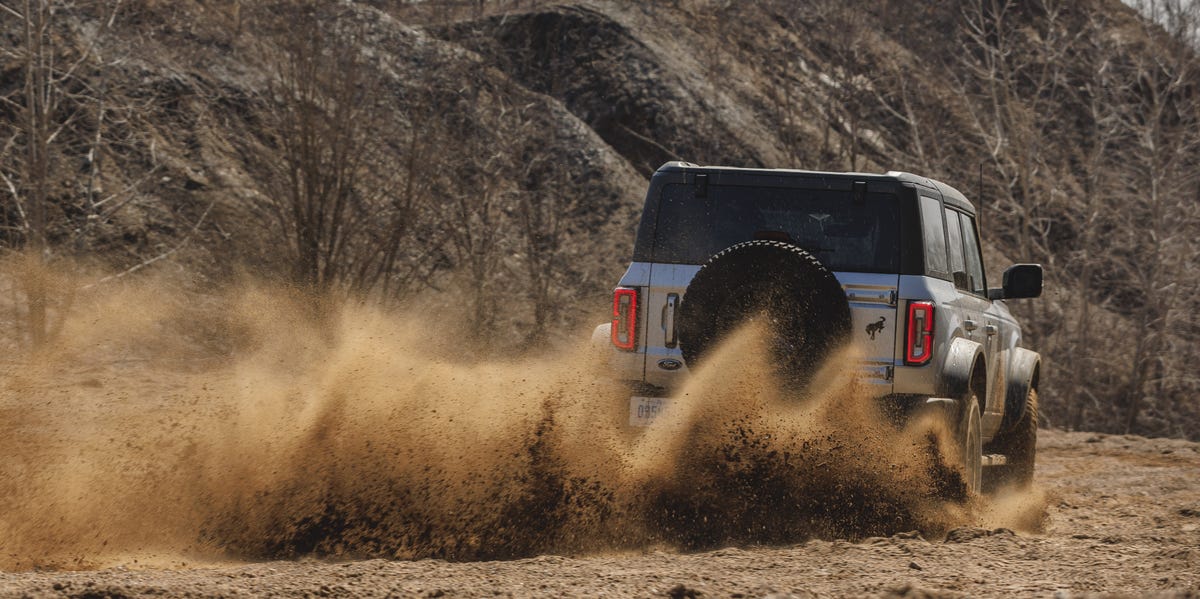2021 Ford Bronco Wildtrak Tested: The Ultimate Bronco (for Now)

The Ford Bronco universe is at a steady simmer now that the Blue Oval’s reimagined off-road icon has become part of the landscape (quite literally in the case of the one that got beached on a sand bar in Maine). Internet infamy aside, we’ve begun seeing them every day around metro Detroit, and Ford is readying a second act with the upcoming hard-core Raptor model. But before we indulge in that special version’s 400-plus horsepower and 37-inch tires, we wanted to test a four-door model with the otherwise-gnarliest Sasquatch package—one of the regular truck’s headline configurations.
In truth, we just wanted another excuse to hit the trails. Thus far, we’ve tested two four-cylinder models: a two-door Black Diamond with the seven-speed manual transmission and a four-door Outer Banks with the 10-speed automatic. Plus, we’ve flown through the air in a two-door First Edition, which was mechanically similar to this six-cylinder 2021 Wildtrak example, save for the latter’s additional doors and 15.8-inch longer wheelbase; both trims feature the Sasquatch gear as standard.
Michael SimariCar and Driver
Those unfamiliar with Bronco lingo can refer to our handy trim-level guide. But know that the Wildtrak is an upper-level desert-running setup, complete with 35-inch all-terrain tires, electronically locking front and rear differentials, a lifted suspension with upgraded Bilstein dampers, and seven G.O.A.T drive modes including a Baja setting. Ticking the Wildtrak box also mandates the optional 330-hp twin-turbo 2.7-liter V-6, 10-speed gearbox, a four-wheel-drive system with a full-time Auto 4HI mode, and a shorter final-drive ratio. Those seeking additional mud-bogging capability can check out the new four-door-only Everglades model, which also includes the Sasquatch package yet only comes with the base 300-hp 2.3-liter turbo-four. Likewise, you can spec a manual Sasquatch setup in the Badlands model but only when paired with the smaller engine.
HIGHS: impressive off-road chops, respectable road manners, more practical than the two-door.
Michael SimariCar and Driver
Surprisingly, our 4971-pound test truck weighed less than the two-door First Edition, albeit by a scant four pounds. Chalk up our four-door Wildtrak’s weight savings mostly to it lacking some of the features and amenities found on the relatively luxurious First Edition, particularly the front stabilizer bar disconnect mechanism and the $2195 power-adjustable leather seats. Our test truck made do with manually adjustable cloth chairs, though both arrangements are heated.
The Wildtrak posted a virtually identical 60-mph run (6.2 seconds), quarter-mile pass (15.0 seconds at 92 mph), and modest lateral-grip figure (0.71 g) as did that earlier First Edition. While it did stop from 70 mph in eight fewer feet, at 189, that’s the same distance that the 254-pound-lighter Outer Banks model needed. Given that less-powerful version also was just 0.3-second slower to 60 mph, there’s less of a performance difference between the Bronco’s various trims than you might think.
Michael SimariCar and Driver
It’s a different story, however, when you compare the Bronco to the Jeep Wrangler. Though the extremities of the Jeep’s model range—especially the 470-hp 392 model—are quicker than the Ford, the Wildtrak will easily outrun a comparable Wrangler Rubicon. It’s also hands-down better when it comes to steering and stopping. Step from a conventional street-oriented SUV into the Bronco and it can feel a bit crude, its solid rear axle dancing over mid-corner bumps and the Wildtrak’s off-road-skewed rubber cutting into its responsiveness. But its rack-and-pinion steering and independent front suspension, as opposed to the Wrangler’s recirculating-ball/solid front-axle setup, brings welcome precision to the Bronco’s helm, and its 79.3-inch-wide stance lends it greater composure. Unlike in the always-busy Wrangler, everyday commuting is a nonissue, and chucking the Bronco down a twisty two-track won’t have you second-guessing its willingness to follow commands.
LOWS: Thirst for fuel, prominent wind and road noise, additional doors clutter its iconic design.
Michael SimariCar and Driver
There are some drawbacks, though, particularly the Wildtrak’s thirst at the pump. Our rig averaged just 15 mpg while in our care and returned 17 mpg on our 75-mph highway test, which matches its EPA estimate yet is 1 mpg less than what the First Edition managed. It’s also noisy inside, with the roar of the 35-inch Goodyears and the wind buffeting around our test truck’s optional hardtop contributing to a 73-decibel din at 70 mph. The Bronco’s optional 10-speaker B&O audio system—included in our test truck’s comprehensive $3590 354A Lux package—is highly recommended. While that interior sound reading spikes to 80 decibels under full throttle, we rarely needed to whip the engine hard. With the 10-speed automatic smoothly shepherding the boosted V-6’s 415 pound-feet of torque, there’s plenty of grunt in reserve for hill climbs and overtaking maneuvers. Of course, stepping down to a tamer trim level enhances the Bronco’s day-to-day livability. The smaller-tired Outer Banks model, for example, averaged 19 mpg and scored 22 mpg on the highway.
Michael SimariCar and Driver
The four-door Wildtrak, which costs $2495 more than the two-door version, brings a slightly calmer ride and better high-speed stability from its longer wheelbase. It also offers easier access to the rear seats, though the two-door’s aft quarters are surprisingly accommodating once you climb back there. And there’s more cargo space behind the rear seats: 36 cubic feet versus the two-door’s 22 cubes. The downside, at least to our eyes, is that it simply doesn’t look as clean and well-proportioned from certain angles. That’s not to say we don’t look back fondly at the new Bronco every time we park one, but the two-door’s stockier retro profile just makes us smile a little bigger.
In essence, if you enjoy high-speed shenanigans and want a little extra practicality, the four-door Wildtrak is the Bronco to get. At $50,970 to start ($58,420 as tested), it’s also not terribly expensive for a vehicle imbued with unwavering coolness and serious off-road capability. The more-powerful and wilder-still Bronco Raptor, which only can be had with four doors, certainly will assume that role in the lineup when it goes on sale—for a base price of $70,095, not including the all-too-frequent dealer markups still found on many Bronco window stickers. But we won’t know how much it improves upon the Wildtrak until we can test one later this year.
A car-lover’s community for ultimate access & unrivaled experiences. JOIN NOW
This content is created and maintained by a third party, and imported onto this page to help users provide their email addresses. You may be able to find more information about this and similar content at piano.io




